Blade Runner: Which predictions have come true?
- Published
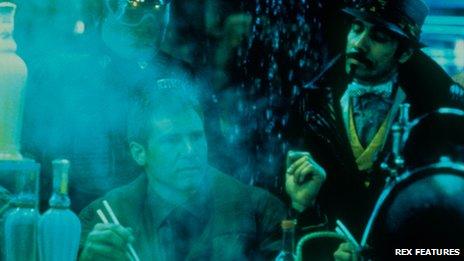
It's been 30 years since the release of Blade Runner and 10 years since Minority Report. Both are rich sources of predictions about the future. But what has actually come to pass?
Based on Do Androids Dream of Electric Sheep? by Philip K Dick, Ridley Scott's Blade Runner - the tale of a hunt for four dangerous "replicant" humans - is a classic envisioning of a dystopian future, set in 2019 Los Angeles.
Minority Report, based on a short story by Dick of the same name, and set in Washington DC in 2054, is another cornucopia of technological possibility, where crime is predicted and therefore prevented.
So which predictions in these movies have been fulfilled?
Languages challenging English
As well as English, some of Blade Runner's 2019 LA residents speak a patois mixing European and east Asian languages.
There has certainly been language shift in Los Angeles, most notably a doubling of the number of Spanish speakers (those who speak the language at home) in the past 30 years from 1.5 million in 1980, external to 3.6 million in 2010, external (including Spanish Creole).
Internationally, Spanish is also significant and futuregazers have gone as far as predicting that one day Mandarin Chinese could become the default language of business worldwide.
Speaking to the New York Times in 2009, external, French linguist Claude Hagege, author of On the Death and Life of Languages, said that Hindi and Mandarin could replace English some day.
Gesture-based computer interfaces
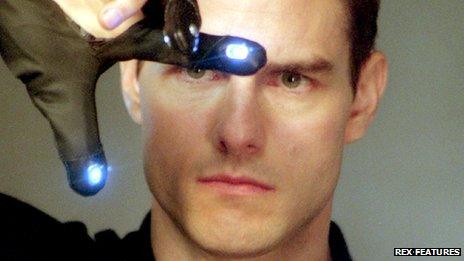
John Anderton, Tom Cruise's character in Minority Report, dons a data glove to use a rather elegant gesture-based interface. Wired magazine reported back in 2008, external that such interfaces would soon become a reality.
John Underkoffler, the scientist who developed the system for Minority Report, set up Oblong Industries to develop and market it. He told TED in 2010, external: "We're not finished until all the computers in the world work like this."

The triumph of touchscreen interfaces is an obvious prelude. The Apple iPhone has offered "pinch", "pull" and "swipe" features for the past five years, and the Microsoft Kinect, external games system allows users to control the action with their movements.
The most recent addition is the Leap gesture-based computer interaction system, launched in May, external. The USB device tracks an area of 8 cu ft for movement, and is capable of differentiating between fingers, thumbs and pencils.
Hover cars

Blade Runner's flying police car
While gesture-based interfaces might seem imminent, at the other end of the prediction spectrum there's hover cars, a concept that is yet to become reality.
As well as flying, vertical take-off and landing, the police car used by Rick Deckard - played by Harrison Ford - in Blade Runner is capable of ground travel.

The Terrafugia Transition can perform as an aircraft or a street-legal vehicle
The car driven by Anderton in Minority Report has an electric engine, body panels that change colour, is self-cleaning and can repair itself. The doors and ignition require a DNA match, meaning it is not easily stolen.
That's not to say there are no flying cars. In April, TekGoblin reported that US company Terrafugia had created the first prototype flying car, external which meets the standards of the FAA (Federal Aviation Administration) and the NHTSA (National Highway Traffic Safety Administration).
But with an expected price tag of about £180,000 ($280,000), it looks like car travel in the air will still not be a daily occurrence for many.
Iris recognition technology
While hover cars are still fantasy, the iris scanning of Minority Report is a reality for many air travellers.
In the film, crime has been eliminated with the aid of technology that constantly monitors citizens. Wall-mounted devices scan human eyes to confirm identity.
"Spielberg hired a team of futurologists to predict technologies," says John de Nardo, editor of SF Signal, a speculative fiction blog.
Even though they cannot be used on moving individuals, as in Minority Report, iris detection devices are used at border agencies all over the world, and were in use at Manchester and Birmingham airports until relatively recently.
Facial recognition technology has been developed and has been rolled out in 25 bars in San Francisco, external. In this case the technology is not being used for national security - but to provide a snapshot of the type of crowd frequenting these establishments.
Personally targeted advertising
The iris recognition technology led to Anderton being bombarded by images targeted specifically at him.

The eyes have it for identity checks
"We are not far away from that," says science fiction writer Robert J Sawyer. Already, internet advertising can be personally tailored to match users' interests.
The parallels between services like Google's DoubleClick and the Minority Report scenario have been made, external. There has also been much discussion about Facebook ads being based on information users share about themselves.
In 2011, a report by the Centre for Future Studies predicted that advertisements would soon be able to adapt to our moods - a technology known as "gladvertising". And according to Digital Ape, external, the effect of Intel's new digital signage systems will be video feeds that can tailor ads to the age and gender of shoppers. Intel itself says the system will release "commercial, financial and entertainment information to specific people groups at specific times".
So perhaps the ads that targeted Anderton are not too far away.
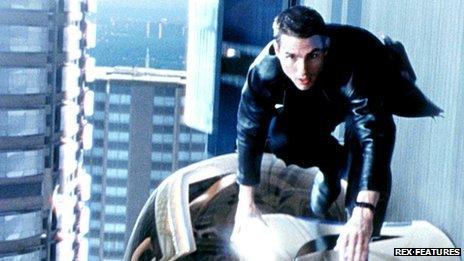
Predictions of wrongdoing
Predictive policing is a big part of Minority Report, in which three psychics, known as pre-cogs, have the ability to see into the future and therefore help stop criminal activity.
"It's about the notion that criminality is innate in people," says Sawyer.
Obviously no force in the world is going to be putting psychics at the heart of their strategy, but there has been growing interest in the idea of mapping future crime trends and even predicting which individuals could become a problem.
In 2006, Tony Blair said state intervention could become "pre-birth even" as it was possible to predict that children born in some circumstances could later become anti-social.
Memphis Police Department in Tennessee is working with IBM on a system that analyses crime trends to predict where police should be deployed. IBM say this has helped reduce crime by 30%, external.
And while we cannot reliably predict who will commit crime in the future, neuroscientists are investigating a way to predict mistakes. The Proceedings of the National Academy of Sciences published a study recording neurological patterns which preceded errors.
This could lead to a system that allows us to intercept our mistakes before we make them - so we won't need the police to do it for us.
Advances in artificial intelligence
While the replicants in Ridley Scott's film seem to be synthetic humans rather than true robots, the film still explores the idea of artificial intelligence.
A key device in the movie is that the replicants do not have a normal emotional range, something that can be detected using a "Voight-Kampff" test to measure empathic responses.
There seems an echo of the many tests used now to measure advances in AI.
Sawyer points out that already scientists have developed machines which can be awarded the Loebner Prize, external, being deemed human-like by a team of experts.
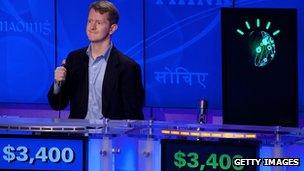
IBM's Watson computing system triumphed in American gameshow Jeopardy
This is based on a test devised by mathematician Alan Turing to determine whether machines can think and use natural language.
But Prof Colin Allen, director of the cognitive science programme at Indiana University, says technology is "not very close" to a machine which can fully pass the Turing test.
At the moment, the closest is IBM's Watson, external, which beat human contestants on US gameshow Jeopardy.
Companies have not yet been able to create a machine that can combine human behaviour and language with the mechanics of human movement, Sawyer adds.
Privatisation of space exploration
Blade Runner envisioned a world where the majority of humankind has chosen to live in more pleasurable "off-world colonies" run by private companies. If such an event happens in the future, it might well be the work of the private sector.
We are now in an era of "gradual decrease in state funding available for space exploration programmes", says Sawyer.
"The political will is not there right now for that kind of exploration," says Karen Burnham, editor of Locus magazine. She points out that Nasa funding fell below 1% of American federal spending in the 1970s and currently represents a mere 0.5% of the 2012 budget.
Although private companies have begun to take over, Burnham says they are a long way from being able to colonise other planets. The private sector has not yet found a way to make space exploration "profitable" beyond 25,000 miles up.
So it looks doubtful that humans will emigrate to other planets by 2019, even though if Newt Gingrich had won the Republican nomination for the American presidential election, he had discussed building a Moon colony to house 13,000 people by 2020, external
Robot morality
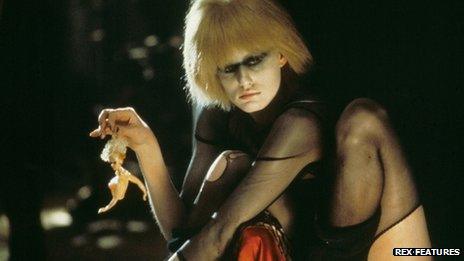
Drawing on the themes in Dick's original story, Blade Runner raised ethical issues surrounding the consequences of creating intelligent life forms in our likeness.
The complication in the film particularly is that the replicants are not robots - they are made of organic materials and bleed, just as humans do. But they lack empathy and were artificially created.
"The question that Blade Runner raises is whether we should award personhood status to machines," says Dr Anne Foerst, associate professor of computer science at St Bonaventure University, New York.
Blade Runner goes "way beyond" the question of artificial intelligence, using the metaphor of technology to explore why society decides certain groups of people are acceptable and others not.
Getting intelligent robots to conform to moral rules is a live area of debate and research, Allen says. At the moment work is under way on developing a control system for military robots, external "to make sure they abide by the rules of combat", and creating robots for use in the care of elderly people, external.